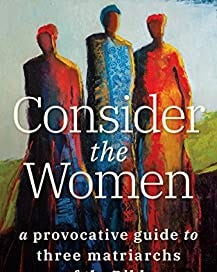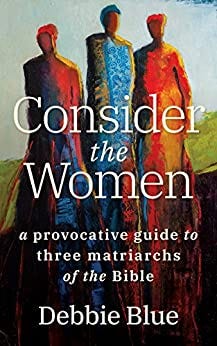Debbie Blue
Consider the Women: a Provocative Guide to Three Matriarchs of the Bible
Grand Rapids, MI: Eerdmans, 2019.
Available at Eerdmans and Koorong
By Laura Joy Paul
Debbie Blue’s book, Consider the Women: a provocative guide to three matriarchs of the Bible begins with the oft-stated, yet nonetheless beneficial, maxim, especially beloved in our day, that “we live and die by stories.” Discussing insights gained from author Rebecca Solnit, Blue writes “We need to think about the stories we tell and their consequences… We need more stories, better stories more complex stories. We need to ask if there are better ways of telling our old stories and if there are stories that we fail to tell about “those players who are not in the limelight”’ (p. 4). Her particular premise is that the Biblical stories of three deeply complex matriarchs—Hagar, Esther and Mary—need to be told and mined afresh for all their subversive perspective and messy, fleshly realities. Blue undertakes this exploration with reference, not just to the role of these women within Christian tradition, but more broadly within the “Abrahamic faiths” (Judaism, Christianity, and Islam) at large. In light of this goal, Consider the Women is then divided into four sections of reflection. The first considers monotheism within the Abrahamic faiths, the second is devoted to Hagar, the third to Queen Esther, and the last to Mary. The result is a broad, creative, and often intriguing, and, at times, provocative take on three important Biblical narratives.
Blue is undoubtedly a creative and gifted writer. In her style, one can taste hints of a Don Miller memoir-esque approach, with a good seasoning of Anne Lamott’s provocative irreverence, and a hint of Madeleine L’Engle’s imaginative, if not necessarily always orthodox, questioning. These features when combined do make for an enjoyable read with some illuminating moments, memorable turns of phrase, and disarmingly humorous insights.
And yet, while playful irreverence can at times free us up to take ourselves less seriously and God more seriously, at other times it can blunt us to the reality of the holiness and inspired revelation of the Word of God. When Blue shows her hand with respect to where she stands on a doctrine of revelation, she appears to say that she believes that revelation relates to the questions we bring to Scripture, rather than to Scripture in and of itself (p. 2). Understandably, this commitment brings with it a tendency to produce a highly deconstructionist reading of Biblical texts. Some readers will find this stimulating, however, for others –most especially those with a commitment to historic Christian orthodoxy—the “provocative” in Blue’s title (upon which she most assuredly does deliver) is likely to be an experience in frustration rather than stimulation.
Thus, all in all, if you are after a book that provides a creative, engaging, and subversive exploration of the narratives of several key Biblical women, then you will likely find Consider the Women an enjoyable read. If, however, you also desire a book firmly grounded in historic Christian orthodoxy, you might find this book less than satisfying.





One of the most common questions I have heard from women over the years is, "why don't we hear in teaching and preaching more about the women of the Bible? "Why are they given a subservient role? We need, as women, to hear more about their life, their struggles, their dreams. We need female role models. It seems that this book, in part, addresses some of those issues.